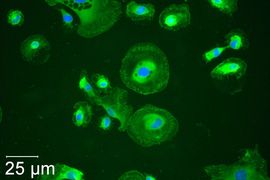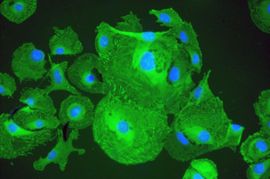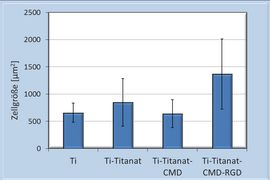Influencing Cell Differentiation by Growth Factors
The chemical and morphological nature of the implant surface plays a key role for the ingrowth of an implant into the surrounding hard tissue (bone, tooth). It is also crucial for the permanent bony anchoring (osseointegration) and the performance of the implants' functions. A suitable modification of the implant surface can accelerate the ingrowth of the implant. It may improve the compatibility of the implant and its anchoring in bone tissue and, therefore, can shorten the healing process for the patient. Conversely, the chemical and morphological nature of implants can also be designed to ease their extraction from bone, should they need to be removed.
Proteinogenic growth factors, like Bone Morphogenetic Proteins (BMP), are able to stimulate bone formation and are suitable for the coating of implant surfaces to induce new bone formation. BMP-2 is primarily relevant for the field of medicine, preferentially being used as recombinant human BMP-2 (rhBMP-2) in the form of a matrix for replacement of the body's own bone structures. In order to develop its osteoinductive properties, rhBMP must be locally available in certain amounts.
The efficacy of the BMP-2 has been proved by inducing the activity of alkaline phosphatase in mouse pre-osteoblasts (MC3T3-E1) (image sequence below). Since rhBMP-2 is readily water-soluble, coating with rhBMP-2 alone does not achieve a permanent effect. Based on adducts from BMP-2 and ionic polymers, we have developed a system for delayed rhBMP-2 release. Natural, degradable biopolymers, based on polysaccharides with various anionic and cationic groups, were modified to get these adducts. Combined with rhBMP-2 in aqueous solution, it forms precipitates of low solubility, that adhere well to the implants' surface. The cytocompatibility of the ionic polymers and the osteoinductive properties of the rhBMP-2 released from these BMP polymer adducts have been proved in in-vitro experiments.
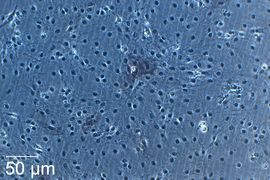
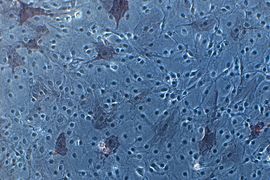
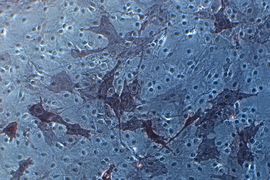
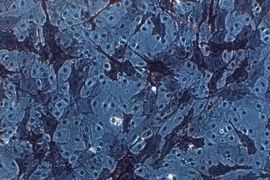
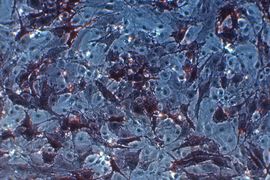
Improvement of Cell Adhesion
Another approach to improve the ingrowth behavior of implants is the stimulation of cell growth by immobilizing cell-adhesion-promoting molecules on the implant surface. The amino acid sequence arginine-glycine-aspartic acid (RGD sequence), for example, is a known motif of many proteins in the extracellular matrix. In particular, it plays an important role in integrin-laminin binding.
To enable the connection of cell-specific ligands, new coating systems for metal or ceramic implants have been developed that generate RGD-functionalized surfaces. Implant surfaces were activated using water vapor plasma and treated with adhesion promoters to bind carboxymethyldextran (CMD). In a second step, a bifunctional linker was coupled to unbound carboxyl groups of the CMD. Finally, an RGD peptide was linked by disulfide exchange. The new layer was then examined by XPS measurements.
In vitro investigations and vinculin immunofluorescence staining (in combination with a DAPI core staining) has shown that the average cell area of mouse fibroblasts (3T3 cells) that had been spread on RGD-containing dextran layers increased significantly, when compared to ones with RGD-free coatings. Further adhesion promoters, polymers and other cell-adhesion-promoting molecules can also be used. Along with vinculin staining, adhesion washing tests can also be used as a biological testing method to determine the number of adherent cells after different periods of time.




